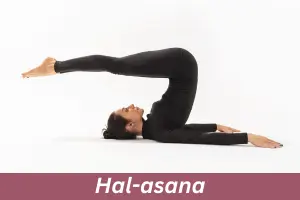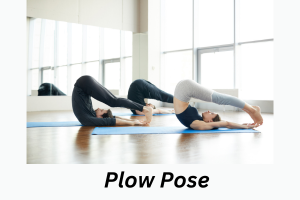Introduction
Halasana, or Plow Pose yoga, is a classic inverted yoga posture known for its calming and restorative effects.
The name is derived from the Sanskrit words Hala, meaning plow and Asana, meaning pose.
This posture mimics the shape of a traditional plow used in farming, symbolizing the preparation of the mind and body for growth


Halasana is known for its numerous health benefits, especially its ability to stretch and strengthen the spine, stimulate the thyroid, and improve digestion.
It is often practiced toward the end of a yoga session due to its restorative nature.
Although it may look challenging, with proper guidance and regular practice, Halasana can help deepen flexibility and enhance mental clarity.
Steps to Perform Halasana (Plow Pose Yoga)
- Start in Supine Position: Begin by lying flat on your back with your legs extended and your arms resting beside your body, palms facing down.
- Lift the Legs: Inhale deeply and engage your core. Slowly lift both legs off the floor until they are perpendicular to the floor. Keep your legs straight.
- Lift the Hips: With your core engaged, use your hands to support your lower back and gently lift your hips off the floor. Allow your legs to move over your head.
- Lower the Legs Overhead: Continue to lift your hips and lower your legs behind your head until your toes touch the floor. Keep your legs straight, and if your feet don’t reach the floor, keep them hovering above it.
- Hold the Pose: Once in position, release your hands from your lower back and place them flat on the mat, palms down, or interlace your fingers behind your back. Keep your neck relaxed and breathe deeply.
- Maintain Alignment: Ensure your back is straight, and your legs are fully extended. Your chin should gently press against your chest, creating a soothing stretch for your neck.
- Hold for 30 Seconds to 1 Minute: Stay in this position for as long as comfortable, breathing slowly and deeply. Focus on stretching your spine and maintaining a calm, steady breath.
- Exit the Pose Gently: To release, bring your hands back to support your lower back. Slowly roll your spine down one vertebra at a time until your legs return to the starting position on the floor.
Benefits of Halasana (Plow Pose Yoga)
- Improves Flexibility: Halasana provides an intense stretch to the spine, shoulders, and legs, promoting increased flexibility and mobility in these areas.
- Strengthens the Back and Core: This pose engages the core and lower back muscles, helping to build strength and stability.
- Stimulates the Thyroid Gland: By compressing the neck, Halasana stimulates the thyroid gland, helping to regulate metabolism and balance hormones.
- Enhances Digestion: The compression of the abdomen massages the digestive organs, improving digestion and reducing bloating or constipation.
- Reduces Stress and Fatigue: This inversion helps to calm the nervous system, relieving stress, anxiety, and mental fatigue.
- Boosts Circulation: The inverted nature of Halasana encourages increased blood flow to the brain and upper body, rejuvenating the mind and enhancing concentration.
- Relieves Back and Neck Pain: The deep stretch along the spine helps to alleviate tension and discomfort in the back and neck, improving posture over time.
- Promotes Relaxation: Halasana has a calming effect on the mind, making it an ideal pose for winding down at the end of a yoga session or before bedtime.
Precautions and Contraindications for Halasana (Plow Pose Yoga)
- Neck and Spine Issues: Individuals with neck injuries, slipped discs or chronic back pain should avoid Halasana or practice it under the supervision of a yoga instructor.
- High Blood Pressure: Since this is an inversion, people with high blood pressure or cardiovascular issues should consult their doctor before attempting this pose.
- Pregnancy: Pregnant women should avoid this pose due to the intense compression of the abdomen and the inverted nature of the posture.
- Glaucoma or Eye Conditions: The increased pressure on the head and neck may aggravate conditions such as glaucoma. It’s best to avoid the pose if you have serious eye conditions.
- Menstruation: Women during their menstrual cycle may want to avoid inversions like Halasana, as they can disrupt the natural flow of energy in the body.
- Shoulder or Elbow Injuries: If you have any shoulder or elbow injuries, this pose may put unnecessary strain on these joints, so practice with caution.
Conclusion
- Plow Pose yoga is a deeply restorative yoga posture that offers a wide range of benefits, from improving flexibility and strengthening the core to reducing stress and promoting relaxation.
- While it may take time to master the pose, regular practice will enhance your overall strength, flexibility and mental clarity.
- Whether you’re seeking to improve your spinal health, stimulate your thyroid, or simply relax your mind, This pose is an excellent addition to your yoga routine.
- Just remember to practice with mindfulness, focus on alignment, and respect your body’s limitations.
- With patience and dedication, This Pose can help you achieve a deeper connection between body and mind, leading to a more balanced and peaceful practice.
